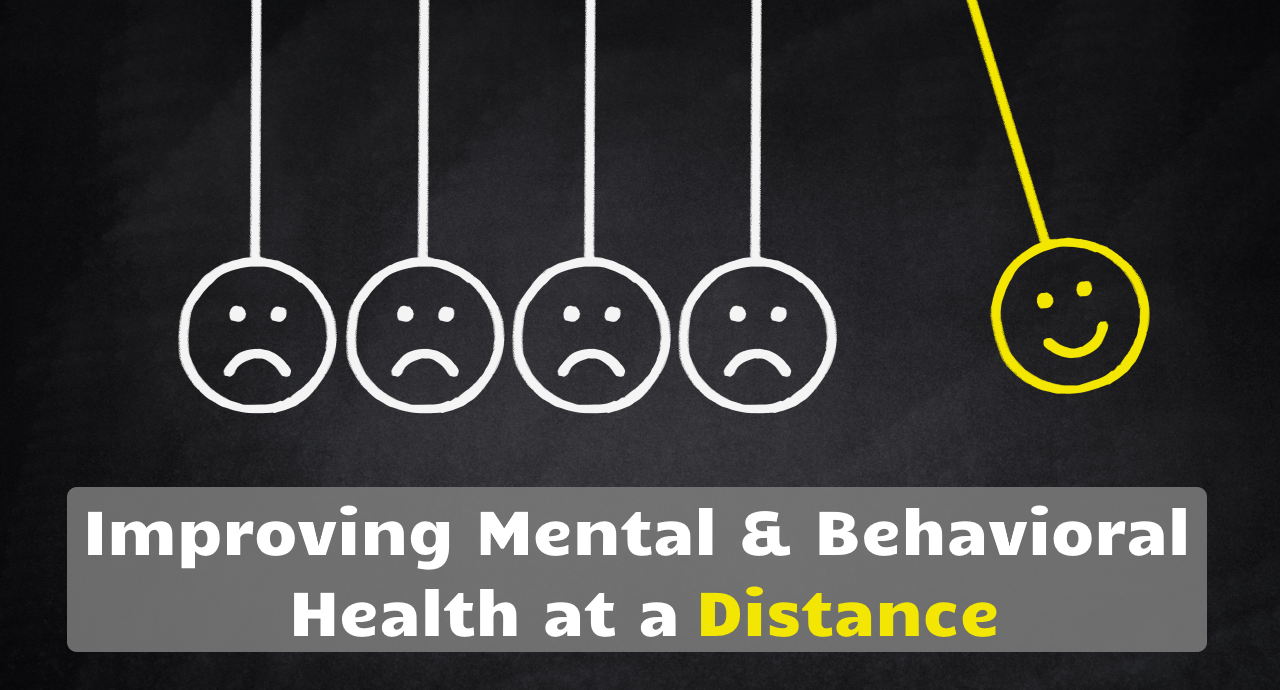The use of video visits for the treatment of mental and behavioral health was one of the first applications of telehealth. But over the past decades TeleBehavioralHealth (which includes TeleMentalHealth) has evolved into a cornucopia of “care at a distance” scenarios.
In this telemedicine services spotlight article, I’ll be shining a light on how multiple facets and modalities of this telemedicine service and how it is destined to help millions of people.
Well, how well does it work?
The most important question in any healthcare delivery setting is to assess the health outcomes. Especially these days as we are emerging from a year-long health crisis that drove virtually every health service to telehealth, it is important to take a hard look at how efficacious a telehealth service really is.
With TeleBehavioralHealth having been around for so long, the good news is that there is plenty of research that has been conducted over the past decades. And the verdict is simple: you can provide the same services and apply the same methods on the same patients and achieve the same efficacy.
Same Services: As the Covid-19 health crisis has demonstrated, virtually all in-person behavioral health services can also be delivered via video. From group visits or behavioral observation, with a little bit of creativity any mental or behavioral health service can be provided via video.
Same Methods: Since TeleBehavioralHealth does not rely on any “widgets, gadgets or scopes”, the same theoretical methods and techniques can be utilized in the delivery of care at a distance. Some may need to be adapted to the new environment, but the underlying principles can easily be replicated.
Same Clients: The same can be said about the clients. While there may be some circumstances where for a particular client remote treatment is not as efficacious as an in-person visit, in most cases remote care will outperform no care any time. As we’ll review below, adapting the remote care modality can also improve outcomes.
Same Efficacy: The research literature supports the efficacy of nearly all telemental and telebehavioral health services. While the speed of advancements has definitely outpaced the research progress in the form of well-designed randomized controlled trials, research over the past two decades has repeatedly confirmed that “Telemental health care can provide effective and adaptable solutions to the care of mental illnesses.”
Especially when studying the efficacy of available behavioral health care in isolated or underprivileged communities, the advantages of TeleBehavioralHealth become immediately apparent.
What sold me on TeleBehavioralHealth
When I started Ingenium in 2012, “my” first patient was a 96 year-old nursing home resident who had seemingly fallen into a deep depression. Whereas before she was the center of the nursing home’s social life, she had now lost interest in virtually all activities.
The problem was that she had no family nearby and that the nearest psychiatrist was 30 miles away from this nursing home in a small town of 2,500 in rural Minnesota. There was therefore no way that she would get access to psychiatric care since neither the nearest psychiatrists had the time to make the drive, nor did the nursing home have the resources to get her the appropriate care.
Once we set up the telehealth solution in the facility, she was our first patient and the nursing home’s social worker led her to a chair in front of our telemedicine cart with a 28” monitor that was at eye level with the resident.
After the initial consult she was amazed: “It was just like the good doctor was here. The image was so clear and I could clearly hear her. And she was so nice, so nice.” That was a proud moment in the launch of our telehealth service.
The real reward, however, came when three months later I stopped by the nursing home again to check in and I saw her in the common room, surrounded by her friends, chatting along. That’s when I knew that this technology, this service can really make a difference.
The Many Facets of TeleBehavioralHealth
In my webinars I often bring up a slide that shows that there are 10,368 use cases for telehealth, which is the combination of the different variables such as the patient location, the clinical specialty, whether it’s ad hoc or prescheduled and what the relationship is with the physician that is rendering the service.
That number, though, is wildly underestimated if we look just at the multitude of different telemedicine services that we can identify when it comes to TeleBehavioralHealth.
First off, there are the variety of different types of behavioral health providers that can deliver care at a distance. From psychiatrists to LCSWs from psychiatric nurse practitioners to DEA-licensed MAT experts multiplied by the number of different treatment methods applied as in in-person care.
One of the things I learned during my 12-year tenure at the Mayo Clinic is that the future of healthcare is one of sub-sub-sub specialization. My favorite example is the world-renowned surgeon performing small bowel transplants on toddlers. It’s what he does mostly in his practice and naturally (given the law of 10,000 hours) he has become extraordinarily good at it. And if your child needs that procedure, that’s the surgeon you want.
The same holds true for the treatment of mental and behavioral health. Postpartum depression treatment requires a different set of skills and experiences than the treatment of post-traumatic stress disorders. It may even require a different set of tools, such as assessments, that can be administered remotely.
And telehealth facilitate access to sub-sub-specialized mental health providers such as an LGBTQ-informed counsellor focused on eating disorders.
As an example of the breadth of services, consider this illustrative, inconclusive list of common TeleBehavioralHealth services:
- Behavioral and Psychiatric Assessments
- Psychiatric Evaluations
- Individual Counseling
- Group Therapy
- Clinical Supervision
- Intensive Outpatient Programs (IOP)
- Behavioral Health Case Management
- Psychiatric Medication Management
- Medication Assisted Treatment (MAT)
- Pre-Trial Intervention (PTI)
- etc.
The Modalities of TeleBehavioralHealth
The next dimension in the multitude of facets of TeleBehavioralHealth is the modality. While our archaic fee-for-service reimbursement system mostly only recognizes (i.e., pays for) live video telehealth visits, there are numerous proven ways to leverage other modalities to deliver care effectively.
One alternative is the telephone and telephonic care, during the Covid-19 crisis where reimbursement restrictions were lifted, was a very viable alternative to “no care”. Under certain circumstances — e.g., lack of access to technology or a personality that makes one clam up in front of a camera, etc. — telephonic care, at the discretion of the provider, reportedly even proved to be the better option.
A third and rapidly increasing modality is text-based communication, which has especially enjoyed traction in the cash-pay counselling environment (with services such as BetterHelp, TalkSpace). As our society is moving more and more toward text-based communication (WhatsApp, Messenger, Slack, …) this modality enjoys strong support as it satisfies our human strive for “instant gratification” by being able to “offload” our concerns immediately.
A fourth modality, that is also emerging, is the field of Virtual Reality where clients can immerse themselves into guided, safe experiences. With the commercial availability of decent-performing virtual reality solutions, this technology can also be used for good to treat behavioral health challenges.
A separate modality that bears mentioning is the use of apps and questionnaires such as online PHQ-9s, computerized Cognitive Behavioral Therapy (cCBT), etc. These electronic tools can be delivered directly while being administered remotely.
The Future of TeleBehavioralHealth
With the increased acceptance of telehealth triggered by the Covid-19 health crisis; with the increasing advancements in technology and AI (augmented intelligence); and with the increasing need for and decreasing availability of adequate behavioral care professionals, we need to rethink how behavioral health can be delivered at scale.
In my non-clinical observation behavioral health challenges are often the underlying causes for many of the chronic diseases which in turn create new or exacerbate existing behavioral health challenges (what in Engineering we’d call a feedback loop). To stop of out-of-control-spiraling of our increasingly stressed society, we need to rethink how we can improve our collective state of mind and telehealth plays a key role in solving this puzzle.



I’m inspired by an innovative psychiatric care model that I learned about in 2017 where a single psychiatrist was managing the care of 1,000s of patients with over 15,000 annual visits by supervising a team of psychiatric nurse practitioners and health coaches, taking full advantage of telephone, video and online apps to manage the care and driving outcomes.
It’s that level of innovative systems thinking that we need not just in TeleBehavioralHealth but in all areas of chronic care management so we collectively can move from “sad” to “happy”.
In the next article in this 3-part series we are exploring how to take Telebehavioral Health to the next level.








To receive articles like these in your Inbox every week, you can subscribe to Christian’s Telehealth Tuesday Newsletter.
Christian Milaster and his team optimize Telehealth Services for health systems and physician practices. Christian is the Founder and President of Ingenium Digital Health Advisors where he and his expert consortium partner with healthcare leaders to enable the delivery of extraordinary care.
Contact Christian by phone or text at 657-464-3648, via email, or video chat.







Leave A Comment